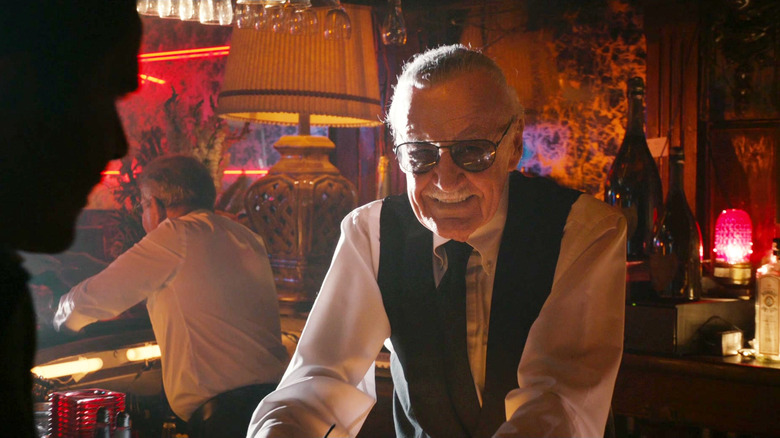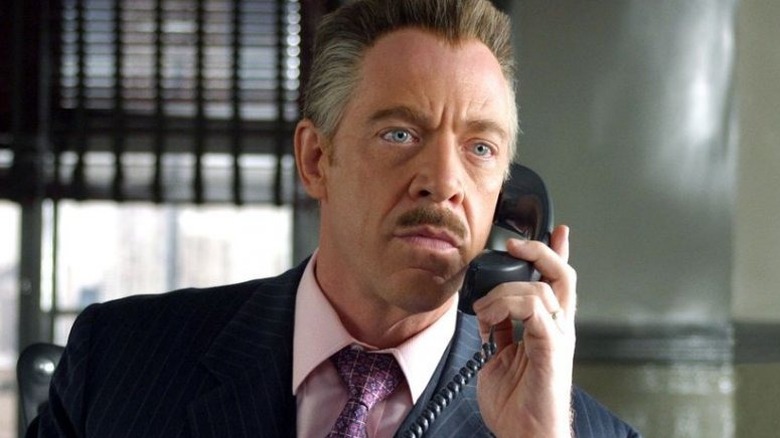Stan Lee Was Jealous He Didn't Get To Play One Marvel Movie Character
Stan Lee is remembered as the father of the Marvel Universe mostly because he was a good marketer. A natural salesman, Lee stoked the early fires of fandom and presented himself to the public as the gas giant around which all of Marvel editorial orbited.
Lee's reputation has been cemented thanks to all the cameos he made in Marvel movies before his death in 2018. Some of his cameos are blink and you'll miss it, others are more substantial. In the 2005 "Fantastic Four" film, he even appeared as a named comic character: Baxter Building mailman Willie Lumpkin. However, there was a different Marvel Comics character that Lee most wanted to play: J. Jonah Jameson, editor in chief of the Daily Bugle and a yellow thorn in Spider-Man's side.
Actor J.K. Simmons discussed this during a GQ video about his most famous roles. Simmons has played Jameson in every "Spider-Man" movie the character has appeared in (no matter the continuity). For his GQ interview, he shared a conversation he once had with Lee about the role:
"You know, JJJ was kind of based on Stan. That was his comic version of himself. And he confessed to me at the time that he was a little jealous that they didn't ask him to play the part in the movie, 'But having seen you seen you do it I thought you were fantastic.'"
Lee was editor-in-chief of Marvel Comics, Jameson is editor-in-chief of the Daily Bugle. Both men are publicity hounds with ears for colorful headlines; the movie Jameson is the one who coins the names of super-villains, just like how Lee dreamt up nicknames for people working at Marvel offices ("Stan The Man"). Jameson's mustache even evokes Lee's famous whiskers.
Stan Lee claimed that J. Jonah Jameson was based on himself
Jameson isn't necessarily a flattering self-portrait of Lee, though. In the earliest Spider-Man comics (i.e. the ones Lee actually wrote), Jameson is a money-grubbing sensationalist. He has none of the noble shades he'd later develop, like firm journalistic principles and a soft spot for Peter. In these early issues, Jameson also always pays Peter less than he's worth. Remember: Peter is a photographer who supplies the images for stories about Spider-Man. Perhaps Lee was thinking about his own professional relationships with Marvel Comics' freelance artists like Jack Kirby and Steve Ditko?
On that note, it's important to remember that Lee often self-mythologized. He nodded along to claims that the X-Men were a '60s civil rights metaphor, or that the militant Magneto was a Malcolm X allegory, but read those early "X-Men" comics and you'll realize that's not true. As a rule, I'd say one shouldn't take Lee's own stories about his time at Marvel Comics as gospel. This story, though, I think is safe to call true because some of Lee's old collaborators have backed it up.
In 2016, writer John Trumbull interviewed six veteran Marvel Comics writers for their thoughts on Jameson (Gerry Conway, Marv Wolfman, Tony Isabella, Roger Stern, Kurt Busiek, and Tom DeFalco). The article, published in the 91st issue of "Back Issue!" magazine, was titled "J. Jonah Jameson: Hero or Menace?"
DeFalco told "Back Issue!" — "[Jameson] bears a striking resemblance to Stan Lee in so many ways. Like Stan, Jonah can be bombastic and self-promoting. He can also be compassionate and driven."
Conway also recounted:
"When I wrote Jameson, I heard Stan Lee's voice. And I think Stan, even in the creation of Jameson, whether intentionally or not, was parodying his own 'Stan Lee, Publisher' persona. So just like Stan is a very complex and interesting guy who both has a tremendously charismatic part of himself and is an honestly decent guy who cares about people, he also has this incredible ability to go immediately to shallow."
Comic book characters are often black-and-white, but Jameson is one who reaches real human complexity despite his hammy persona. It seems like he inherited that split soul from his own creator.

